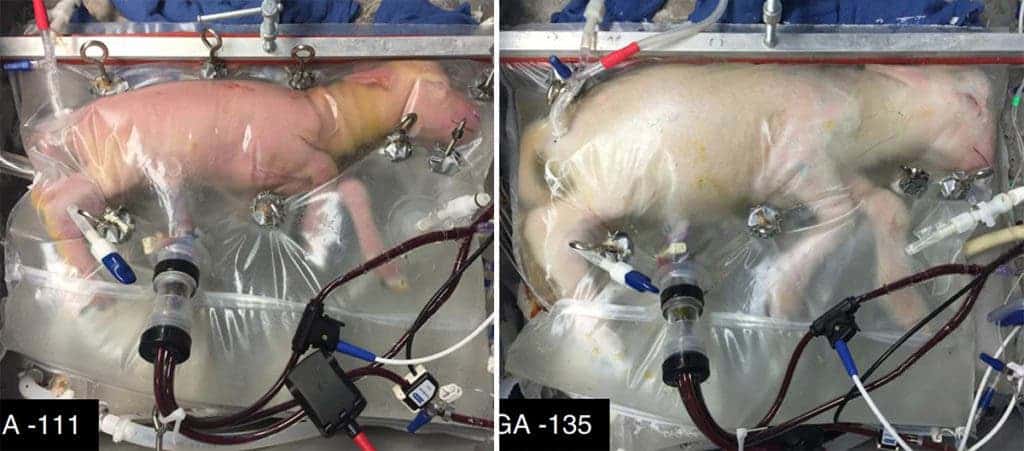Premature babies often can’t survive because their tiny organs haven’t had enough time to develop. Doctors at the Children’s Hospital of Philadelphia (CHOP) want to give these babies a fighting chance. They’ve recently demonstrated a womb-like environment filled with a substance that mimics the prenatal fluid. The system was tested on lambs which showed normal growth and looked healthy after a few weeks of gestating in the womb-like sac.

This extra-uterine support system is the culmination of three years of hard work and the last of four prototypes. At first, the team led by Alan W. Flake, MD, a fetal surgeon at CHOP, started with a glass incubator tank, then gradually improved their design borrowing ideas here and there from previous work done by other researchers who had been working on artificial wombs or similar life support systems.
The system is made up of a fluid-filled container attached to custom-tailored machines that provide physiological support. Sensors and automation ensure the environment is almost perfectly sterile and the temperature is constant. The device, however, doesn’t use external pumps to circulate blood nor ventilators. Because the heart and lungs are so underdeveloped, even a gentle artificial pressure is enough to break the fragile organs. Immature lungs can’t breathe atmospheric oxygen.
Instead, the fetal lambs breathe amniotic fluid as they normally would in the womb and their own hearts pump blood through the umbilical cord that’s connected on the other end to a gas exchange machine placed outside the container bag. A low-resistance external oxygenator substitutes for the mother’s placenta in exchanging oxygen and carbon dioxide.
The team tested its extra-uterine device on eight preterm lambs which were physiologically equivalent to a 23- or 24-week-gestation human infant. The limit of survival of premature human infants is about 22 to 23 weeks of gestation. At this age, an infant weighs only 0.6 kilograms (a little more than a pound) and only has a 30 to 50% chance of survival, depending on the severity of the prenatal birth. If they do survive, severely premature babies often face chronic health problems due to organ immaturity, for all of their adult lives. Disability is very common and the morbidity risk is much higher than average.
So, the goal is to support infants from 23 weeks to 28 weeks gestational age; at 28 weeks they cross the threshold away from the most severe outcomes.
“These infants have an urgent need for a bridge between the mother’s womb and the outside world,” said Flake. “If we can develop an extra-uterine system to support growth and organ maturation for only a few weeks, we can dramatically improve outcomes for extremely premature babies.”
These findings shine a ray of hope for the 30,000 or so critically preterm babies that get born yearly in the United States. After four weeks of development inside the fluid-filled container, the lambs opened their eyes and seemed healthy. The lambs grew wool, became more active, and had normal growth, neurological function, and organ maturation, as reported in Nature Communications.

The team will next work on refining the system and prepare it for human infant use. A prenatal infant is only one-third the size of an infant lamb so the whole container and life-support system needs to seriously downsized. Doctors are also interested in adding some subtleties like audio recordings that simulate sounds a fetus would normally hear in the womb, like the mother’s heartbeat. Parents would also be able to watch their babies mature through an imaging system.
“We’ll try to make it an environment that is parent friendly, a much less stressful situation than seeing their fetus on an incubator and exposed bed, having IVs started and experiencing painful and uncomfortable stimuli like bright lights,” Flake told ResearchGate.
Flake expects their device could appear in clinical care units in a decade if the results can be adapted for humans. If successful, not only will it save the lives of thousands of babies, it would also help cut down on the estimated $43 billion annual medical costs of prematurity in the U.S.
“This system is potentially far superior to what hospitals can currently do for a 23-week-old baby born at the cusp of viability. This could establish a new standard of care for this subset of extremely premature infants,” Flake said in a statement.




